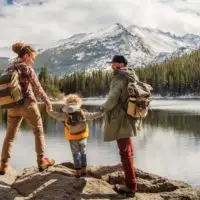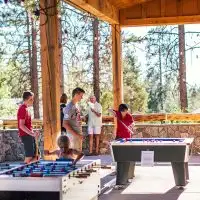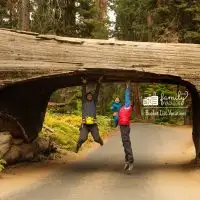Reprinted with permission from IndependentTraveler.com.
Is your family dreaming of getting away to the great outdoors? If so, you’re not alone — national parks in the U.S. see more than 270 million visitors a year. From the scenic mountains of Glacier National Park to the sweeping vistas of the Grand Canyon, national parks are a perennially popular vacation destination for families, outdoor adventurers and travelers in search of natural beauty.
Whether you’re planning on camping in the backcountry for a week or simply driving along the parks’ many scenic roads, we’ve pulled together a few key tips to help you get the most from your national park vacation. Read on to learn how to avoid crowds, plan your trip and stay safe in the great outdoors.
What’s your favorite national park family vacation? Tell us in our National Park Vacations Forum! Also visit our 10 Best National Parks for Families article.
When to Go
Most national parks see their peak crowds in the summertime, when kids are out of school and the weather and scenery are at their best. Campgrounds, lodges and hotels fill up quickly during peak travel times, and the main roads running through the parks often get clogged with cars and RV’s. You’ll often have a better experience if you visit in spring or fall, when most parks are less crowded.
Does that mean you shouldn’t visit during the summer? Absolutely not. While the most popular parks see millions of visitors each year, that doesn’t mean you have to run into all those visitors during your trip. Crowds tend to cluster around major visitor attractions (such as Yellowstone’s Old Faithful) and scenic overlooks (like those along the Grand Canyon’s South Rim), but even the most popular parks have many miles of less discovered hiking trails and backcountry roads far from the tourist trail. If you can, ditch the car and take a hike to find your own little patch of natural beauty away from the crowds. Save the more popular attractions for either first thing in the morning or just before sundown in order to beat the midday rush.
Planning Your Trip
Your first stop should be the Web sites of the National Park Service (for U.S. parks) or Parks Canada (for parks north of the border), both of which provide up-to-date, unbiased information about each park within their jurisdiction. These sites offer maps, trail reports, road closure information, operating hours, activity listings, fee information and much more.
AAA is also a good source for comprehensive national park maps, which members can order at no charge. If you’re not a member of AAA, you can get maps at any visitor center once you arrive at the park.
Each national park has a wide range of lodging options both within the park and outside it, ranging from campgrounds and rustic cabins to budget motels and upscale hotels. Camping is almost always your cheapest option, but keep in mind that campgrounds can fill up quickly during the peak travel season. Many parks allow you to reserve your campsite ahead of time; you can do so at Recreation.gov (for U.S. parks) and PCCamping.ca (for Canadian parks).
Don’t do tents? Budget travelers can stay in cabins within the park or in family-friendly motels outside the main park entrances, while those willing to pay a little more can often stay in elegant lodges with beautiful views of the park. Be sure to check for the amenities that are important to you — not all park lodging will have private bathrooms, for instance. As with campgrounds, park lodges and cabins often sell out very quickly at peak times, so be sure to book well in advance if you have your heart set on staying inside a particular park.
Park Passes
If you’re planning on visiting several parks over the next year, you may want to consider purchasing a park pass. The National Park Service has introduced the new America the Beautiful – National Parks and Federal Recreational Lands Pass, which replaces the former National Parks Pass. At $80 a year, the pass is more expensive than its $50 predecessor, but it includes admission not only to any national park or monument but also to any sites managed by four other government agencies. The pass grants admission for the passholder and his or her vehicle (at sites that charge per vehicle) or for the passholder and up to three other adults (at sites that charge per person). Children under 16 are admitted free.
Seniors aged 62 and up pay only $10 for a lifetime pass, while permanently disabled travelers can get their lifetime pass for free.
National Parks Passes and other discontinued passes will still be honored according to the provisions of each pass.
Canada also offers a variety of park passes. A family pass covers admissions for up to seven people, with a maximum of two adults, traveling in a single vehicle at participating parks. Family passes start at 106.90 CAD. A full list of fees can be found here. Note that not all parks participate in the program, so be sure to make sure the parks you want to visit are included.
What’s your favorite national park family vacation? Tell us in our National Park Vacations Forum! Also visit our 10 Best National Parks for Families article.
Staying Safe in the Parks
It may seem self-evident, but many visitors forget that the wild animals they’re in the park to see are just that: wild. Animal attacks in national parks are rare, but they do happen. Before you arrive in the park, be sure to thoroughly research what types of wildlife you might encounter and learn what to do if you find yourself in danger. Parks Canada has a useful guide to safely enjoying and protecting wildlife. Do not feed the animals, approach them or try to pose for photographs with them.
When with children or pets, be sure to watch them carefully at all times, and never let pets off their leash — small animals look like lunch to bears and other predators, and can lead them straight to your campsite. (Many parks do not allow pets at all, so be sure to check ahead of time.)
Bring plenty of bottled water, especially if you’re planning strenuous activities like hiking, biking or kayaking. For longer hikes, it’s a good idea to bring a water filter or purification tablets; no matter how pure that mountain stream may look, it’s never a good idea to drink water that hasn’t been disinfected or boiled.
You’ll also want to bring along some high-energy snack foods for you and the kids such as fruit, nutrition bars, nuts and trail mix. While many parks have concession stands where you can purchase snacks, your best option is to stock up at a grocery store outside the park — not only will you have a greater selection, but you’ll also pay the prices the locals do rather than the inflated tourist prices inside the park.
To prevent injury (or just pesky blisters!), be sure to break in your new hiking boots at home before you set out on a long schlep through a national park. You may want take the family out walking together a few times in their hiking gear before your trip. Similarly, don’t wait until you’re on the trail to try out your shiny new camping equipment — practice setting it up before your trip so you can do it smoothly when it counts.
Two of the more common afflictions for visitors to national parks are altitude sickness and heat exhaustion. If you are traveling to a mountainous park or will be spending a lot of time outdoors during your trip, be sure to read up on these conditions so that you know how to recognize and treat the symptoms.
No matter where you’re headed, it’s a good idea to pack a first-aid kit in case of illness or minor injury.
Protecting the Parks
National parks were established to protect native plants and wildlife, but these beautiful spaces cannot be maintained without the help of the people who visit them. Respect the natural environment by sticking to marked trails and taking photographs of animals only from a safe distance. Trash should be placed in marked receptacles or taken with you when you leave the park. Leave flowers, rocks and plants untouched — it may not seem like a big deal to take one little stone home as a souvenir, but when thousands of visitors are doing the same thing, the impact is clear. To minimize your carbon emissions, you may wish to park your car and take public transportation instead. Quite a few parks now offer shuttle services, including Glacier, Zion, Grand Canyon and Sequoia.
Visit our Forums for more discussions of National Parks and Family Camping Vacations.
Visit our sister site, Independent Traveler, a comprehensive online travel guide, for a guide to National Parks less traveled.
Our team of parents and travel experts chooses each product and service we recommend. Anything you purchase through links on our site may earn us a commission.






